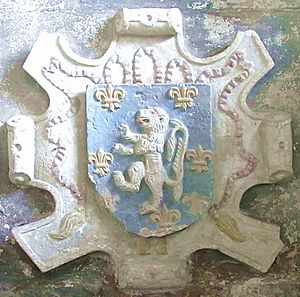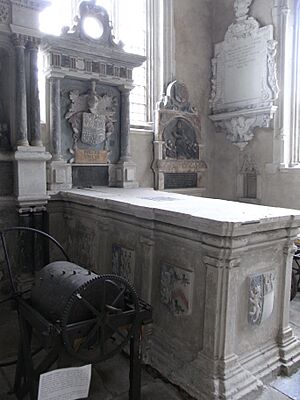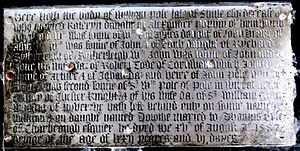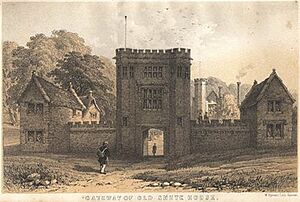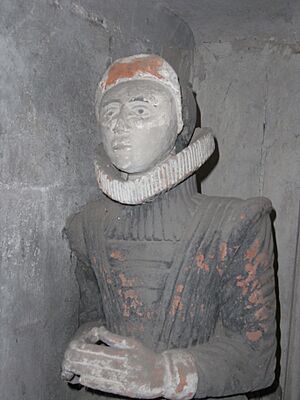William Pole (died 1587) facts for kids
William Pole (born 1515, died 1587) was an important lawyer and politician in England. He bought a lot of land that used to belong to churches after the king closed many monasteries. He was elected as a Member of Parliament (MP) for different towns like Lyme Regis, Bridport, and West Looe. William Pole started a very rich and powerful family in Shute, Devon. He was also the father of the famous Sir William Pole, who became a well-known historian of Devon.
Contents
William Pole's Family Background
William Pole was the only son of William Pole and his second wife, Agnes Drake. Agnes came from the Drake family, an old and respected family in Devon.
A special brass plaque on his monument in Colyton Church tells us about his family tree. It says he married Katherine Popham. It also mentions his parents, grandparents, and great-grandparents. The plaque explains that William Pole was a descendant of the Pole family from Cheshire.
Interestingly, there were two different Pole families. William's family, the Poles of Cheshire, had a coat of arms with a blue shield, gold flowers, and a silver lion. Another Pole family in Devon had a different coat of arms with a red deer's head. William Pole's great-great-grandmother, Johan Pole, was an heiress from this other Devon Pole family.
His Work as a Lawyer and Politician
William Pole studied law at a famous law school called the Inner Temple in London. He became a Fellow there before 1547. This meant he was a senior member. He held important positions at the Inner Temple, including Treasurer in 1564, which was a job of great trust.
He also worked as a Justice of the Peace (JP) in Devon and Dorset starting around 1559. A JP helps keep the peace and deals with local legal matters. He also gave legal advice to the town of Lyme Regis from about 1564.
Lands and Homes He Acquired
William Pole became very wealthy and bought many properties. In 1560, he bought Old Shute House in Colyton, Devon, for £300. This house became the main home for his family for many years. It was later given to the National Trust, an organization that protects historic places.
In 1562, he also got a very long lease (for 1,200 years!) for the Shute estate. His family later bought the land outright in 1788. It's a fun coincidence that the Pole family of Ford, who were distantly related, had ancestors who built the original medieval house at Shute in 1380.
William Pole also bought the manor of Charmouth, which was seven miles from Shute, in 1575. He even gave a silver cup to Charmouth Church in the same year.
Marriages and Children
William Pole married twice, but he only had children with his second wife.
- His first wife was Thomasine Tudboll (died 1556). She was a merchant's daughter from Lyme Regis and had been married twice before.
- His second wife was Katherine Popham (died 1588). She was the daughter of Alexander Popham and the sister of Sir John Popham, who became a very important judge.
William and Katherine had seven children, but only two lived past childhood. This is mentioned on the brass plaque on his monument and on Katherine's own monument in Colyton Church.
Their children who lived were:
- Sir William Pole (1561-1635), who became a famous historian.
- Dorothie Pole, who married twice.
Their other children, Alexander, Hugh, Richard, Arthur, and Amy, sadly died young.
Monument to Katherine Popham
Katherine Popham's monument is next to her husband's in Colyton Church. It shows her kneeling with her seven children around her. An inscription below explains that she was the wife of William Pole and the sister of Sir John Popham, the Lord Chief Justice. It also lists her children, mentioning which ones lived and which died young. She passed away on October 28, 1588. Her son, Sir William Pole, built this monument to remember her.
The monument also has four shields with family coats of arms, showing Katherine's family connections.
Death and Burial
William Pole died on August 15, 1587. He was 72 years and 6 days old. He was buried in the Pole Chapel at Colyton Church, where his son, the antiquary, built a monument to him.
Sources
- Bridie, Marion F., The Story of Shute, Axminster, 1955
- Miller, Helen & Hasler, P. W., biography of William Pole (1515-1587), published in History of Parliament: House of Commons 1558-1603, 1981


